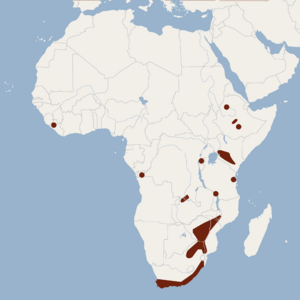Cape hairy bat facts for kids
Quick facts for kids Cape hairy bat |
|
|---|---|
| Conservation status | |
| Scientific classification | |
 |
|
| Distribution of Cape hairy bat |
The Cape hairy bat is a small bat found in parts of Sub-Saharan Africa. It has many other names, like the little brown bat or three-coloured bat. Its scientific name is Myotis tricolor. This bat belongs to a group called vesper bats.
Contents
What Does It Look Like?
The Cape hairy bat is a small bat. It looks a lot like the even tinier rufous mouse-eared bat. Its fur on its back is orangey or reddish-brown. The fur on its belly is a bit lighter. Each hair is dark at the bottom and reddish at the tip. This makes its fur look soft and stand up a little.
This bat has wide, dark brown wings. These wings stand out against its bright body fur. Its face is plain, meaning it does not have a special nose leaf. It has medium-sized brown ears. Inside each ear is a long, narrow part called a tragus. An adult Cape hairy bat weighs about 13.9 grams. That is about as much as two quarters! Its forearm is about 49.5 millimeters long.
Where Do They Live?
The Cape hairy bat has been found in a few different places. In West Africa, it lives in the high lands of north-western Liberia. In central Africa, you can find it in parts of the Democratic Republic of Congo and Rwanda.
It lives in many more places in East Africa. Its range goes from Ethiopia in the north. From there, it spreads south all the way to southern South Africa.
Their Home and Habitat
Cape hairy bats need caves to live in. Because of this, they are found in mountains and rocky areas. These are the places where caves are common. You will not find them in flat areas without trees.
They often make their homes in old, unused mines. They usually like large caves that have pools of water inside. When they are hunting for food, these bats have been seen in different types of environments. This includes dry and wet savannas. They also hunt in areas with Mediterranean-style shrubs.
What Do They Eat?
The Cape hairy bat hunts for insects while flying. They fly along the edges of plants and trees. They catch insects from the air. Their diet includes many different kinds of insects. These include beetles, true bugs, flies, lacewings, and ants, bees, and wasps.
Life Cycle and Reproduction
The Cape hairy bat is a social animal. This means they like to live together in groups. They make their homes in caves. They use different caves for different times of the year. In winter, they might use caves for hibernation. This is a deep sleep to save energy. In summer, females use special caves to have their babies.
A cave where these bats live can hold up to 1500 individual bats. In a place called KwaZulu Natal in South Africa, mating happens in May. After mating, the female bats store the male's sperm. They keep it inside their bodies until September. Then, the sperm is used to fertilize an egg.
The baby bats are born in November and December. Each female bat usually gives birth to one baby at a time. The mothers gather together in special caves to have their young. The baby bats drink their mother's milk for about six weeks after they are born.


